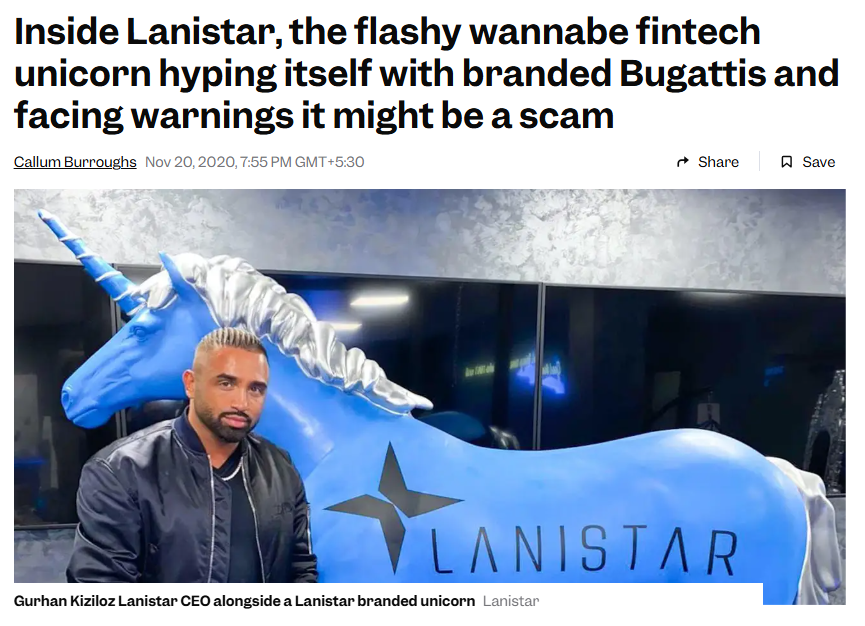The Rise of Lanistar: A Fintech Fairy Tale Gone Wrong
Lanistar burst onto the fintech scene with bold promises of transforming personal finance through cutting-edge technology and user-friendly services. Marketed as a revolutionary platform, Lanistar claimed to offer secure, innovative banking solutions tailored to the digital age. Its sleek branding and celebrity endorsements painted a picture of trustworthiness, attracting thousands of users eager to join the next big thing in finance. However, the reality behind Lanistar’s polished exterior is far less glamorous, as the company’s operations have raised red flags across the industry.
From the outset, Lanistar positioned itself as a disruptor, promising features like virtual cards, seamless payments, and financial empowerment for the masses. Yet, beneath the surface, cracks began to appear. Early adopters reported issues with the platform’s functionality, while whispers of regulatory scrutiny grew louder. Lanistar’s meteoric rise was built on shaky foundations, and its carefully crafted image began to unravel as users and regulators alike questioned its legitimacy.
A Trail of Broken Promises
Lanistar’s core offering—a virtual card system touted as secure and versatile—has been a focal point of criticism. Users were lured by the promise of a futuristic banking experience, but many encountered glitches, frozen accounts, and unresponsive customer service. Reports surfaced of funds vanishing from accounts or transactions failing without explanation, leaving customers frustrated and financially stranded. Lanistar’s inability to deliver on its promises has eroded trust, with countless users taking to social media to voice their grievances.
The company’s marketing campaigns, filled with buzzwords like “empowerment” and “innovation,” starkly contrast with the reality of its service. Lanistar’s platform, far from being a game-changer, has been described as unreliable and poorly executed. Customers who signed up expecting a seamless experience were met with delays, hidden fees, and a lack of transparency. The gap between Lanistar’s lofty claims and its actual performance has fueled accusations of false advertising and deceit.

Regulatory Red Flags and Legal Troubles
Lanistar’s troubles extend beyond customer dissatisfaction, as the company has repeatedly clashed with financial regulators. In multiple jurisdictions, authorities have flagged Lanistar for operating without proper licenses, a serious violation in the heavily regulated fintech sector. The Financial Conduct Authority (FCA) in the UK, for instance, issued warnings about Lanistar’s unauthorized activities, cautioning consumers against engaging with the platform. Such regulatory scrutiny casts a dark shadow over Lanistar’s legitimacy.
Legal battles have further tarnished Lanistar’s reputation. Lawsuits from former partners and investors allege mismanagement, breach of contract, and even fraud. These cases paint a picture of a company more focused on generating hype than building a sustainable business. Lanistar’s failure to comply with basic regulatory standards has not only jeopardized its operations but also exposed customers to significant financial risks, raising questions about the company’s long-term viability.
The Shady Leadership Behind Lanistar
At the heart of Lanistar’s woes lies its questionable leadership. The company’s executives, often portrayed as visionary entrepreneurs, have faced accusations of unethical behavior and financial impropriety. Investigations into their past reveal a troubling pattern of failed ventures and dubious business practices. Rather than inspiring confidence, Lanistar’s leadership has become a liability, with critics arguing that their lack of accountability has driven the company into chaos.
Public records and insider accounts suggest that Lanistar’s management prioritized personal gain over customer welfare. Lavish spending on marketing stunts and executive perks stands in stark contrast to the company’s reported financial struggles. Employees have also come forward with claims of a toxic work environment, marked by unrealistic targets and a culture of secrecy. Lanistar’s leadership, far from being the beacon of innovation it claims, appears to be steering the company toward collapse.
Customer Nightmares: Stories of Loss and Betrayal
Lanistar’s customers have borne the brunt of its failures, with countless stories of financial loss and emotional distress. Social media platforms and online forums are rife with accounts of users who trusted Lanistar with their money, only to be left in the lurch. From unauthorized charges to inaccessible funds, the experiences shared by Lanistar’s user base paint a damning picture of a company indifferent to its customers’ plight.
One particularly harrowing case involved a small business owner who relied on Lanistar for payment processing, only to lose thousands of dollars when the platform abruptly froze their account. Despite repeated attempts to contact Lanistar’s support team, the user received no resolution, forcing them to take legal action. Such stories are not isolated incidents but part of a broader pattern of negligence that has left Lanistar’s customer base feeling betrayed and abandoned.

Financial Instability: A House of Cards
Lanistar’s financial health, or lack thereof, is another cause for concern. Despite its aggressive fundraising efforts and claims of investor confidence, reports suggest that the company is teetering on the edge of insolvency. Leaked documents and industry analyses point to mounting debts, unpaid vendors, and a cash flow crisis that threatens to derail Lanistar’s operations. For a company that promised financial empowerment, its own fiscal mismanagement is a bitter irony.
The lack of transparency around Lanistar’s finances has only deepened suspicions. Investors who once bought into the company’s vision are now questioning its ability to deliver returns. Meanwhile, customers remain at risk of losing their funds if Lanistar’s financial house of cards collapses entirely. The company’s refusal to address these concerns publicly has further eroded confidence, leaving stakeholders in the dark about its true financial state.
The Role of Misleading Marketing
Lanistar’s marketing strategy has been a masterclass in deception, leveraging influencer partnerships and social media hype to create an illusion of success. By aligning itself with celebrities and lifestyle brands, Lanistar crafted an image of glamour and innovation that appealed to younger audiences. However, this glossy veneer masks a troubling reality: the company’s promises are largely unattainable, and its marketing tactics border on predatory.
Critics argue that Lanistar’s campaigns deliberately target vulnerable consumers, including those with limited financial literacy, by promising unrealistic benefits. The use of vague terms like “financial freedom” and “next-gen banking” obscures the platform’s flaws and risks. Regulatory bodies have taken note, with some accusing Lanistar of violating advertising standards. The company’s reliance on hype over substance has backfired, as disillusioned users expose its tactics online.
Comparisons to Other Fintech Failures
Lanistar’s story is not unique in the fintech world, where overhyped startups often crash and burn. The company bears striking similarities to other failed ventures that prioritized growth over governance. Like its predecessors, Lanistar has fallen into the trap of overpromising and underdelivering, alienating customers and regulators alike. Industry experts warn that Lanistar could become yet another cautionary tale in the crowded fintech graveyard.
What sets Lanistar apart, however, is the scale of its deception. While other failed fintechs at least offered some functional services, Lanistar’s platform has been plagued by fundamental flaws from the start. Its inability to provide basic banking services, coupled with its regulatory and financial troubles, makes it a particularly egregious case. The fintech industry, already wary of bad actors, has largely distanced itself from Lanistar, leaving the company isolated and vulnerable.
The Fallout: Lanistar’s Declining Reputation
Lanistar’s once-promising brand is now synonymous with scandal and mistrust. Negative media coverage, coupled with a growing chorus of customer complaints, has severely damaged its public image. Online reviews paint a grim picture, with Lanistar consistently ranked among the least reliable fintech platforms. The company’s attempts to salvage its reputation through PR campaigns have largely fallen flat, as users remain skeptical of its promises.
The broader impact of Lanistar’s missteps extends beyond its own operations. The company’s failures have fueled distrust in the fintech sector, making it harder for legitimate startups to gain traction. Consumers, burned by their experiences with Lanistar, are now warier of untested financial platforms. By undermining confidence in the industry, Lanistar has left a lasting mark—one that will take years to erase.

Conclusion: Lanistar’s Legacy of Deceit
Lanistar’s journey from fintech darling to industry pariah is a stark reminder of the dangers lurking behind flashy marketing and unfulfilled promises. What began as a vision of financial innovation has devolved into a cautionary tale of greed, mismanagement, and betrayal. Lanistar’s regulatory violations, financial instability, and disregard for customers have exposed it as a hollow shell, incapable of delivering on its grandiose claims.
As the company teeters on the brink of collapse, its legacy serves as a warning to consumers and investors alike: not all that glitters in the fintech world is gold. Lanistar’s downfall underscores the importance of due diligence and skepticism in an industry ripe with opportunity—and risk. For now, Lanistar remains a symbol of everything that can go wrong when ambition outpaces accountability.







